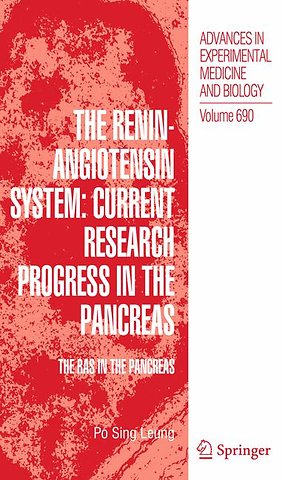The Renin-Angiotensin System: Current Research Progress in The Pancreas
The RAS in the Pancreas
Samenvatting
The human pancreas consists of two organs in one: the exocrine gland made up of pancreatic acinar cells and duct cells that produce digestive enzymes and sodium bicarbonate, respectively; the endocrine gland made up of four islet cells, namely alpha-, beta-, delta- and PP-cells that produce glucagon, insulin, somatostatin and pancreatic polypeptide, respectively. While the physiological role of exocrine p- creas is to secrete digestive enzyme responsible for our normal digestion, absorption and assimilation of nutrients, the endocrine pancreas is to secrete islet peptide h- mones maintaining our glucose homeostasis. The pancreatic functions are nely regulated by neurocrine, endocrine, paracrine and/or intracrine mechanisms. Thus, dysregulation of these pathways should have signi cant impacts on our health and disease. Nevertheless, the underlying mechanisms by which pancreatic functions are regulated remain poorly understood. Recent basic science and clinical studies con rm myriad physiological and pathophysiological roles of the tissue renin-angiotensin systems (RAS). Of parti- lar interest is the recent identi cation of a local and functional RAS in the pancreas, which in uences both its exocrine and endocrine function. Its role in the pat- genesis of pancreatic diseases including diabetes and pancreatitis is increasingly recognized, as is the therapeutic potential of RAS antagonism: RAS blockade l- its disease progression of type 2 diabetes mellitus and impaired glucose tolerance, and may also protect against pancreatic in ammation.
Specificaties
Inhoudsopgave
4.3. Angiotensinogen.- 4.3. Angiotensin-generating enzymes.- 4.4. Angiotensin and (pro)renin receptors.- 5. Local RAS.- 5.1. Definition of the local RAS.- 5.2. Local RAS in carotid body
5.3. Local RAS in liver.- 5.4. Local RAS in intestine.- 6. Pancreatic RAS.- 6.1. Acinar cell RAS.- 6.2. Ductal cell RAS.- 6.3. Stellate cell RAS.- 6.4. Islet cell RAS.- PART III: RESEARCH PROGRESS OF THE RAS IN PANCREAS.- 7. Basic Techniques for Pancreatic Research.- 7.1. Cell models.- 7.2. Animal models.- 7.3. Islet and acinar cell isolation.- 7.4. Islet transplantation.- 7.5. Expression and functional studies.- 8. Current Research of the RAS in Diabetes Mellitus .- 8.1. Basic studies of the RAS in T2DM.- 8.2. Clinical studies of the RAS in T2DM.- 8.3. Current research on the RAS-vitamin D-T2DM axis.- 8.4. Current research on the RAS-GLP1-T2DM axis.- 9. Current Research of the RAS in Pancreatic Stem Cells.- 9.1. Source of pancreatic stem cells.- 9.2. Current research on pancreatic stem cells.- 9.3. Current research of the RAS on stem cells.- 9.4. Current research of the RAS on pancreatic stem cells.- 9.5. Limitations and future directions.- 10. Current Research of the RAS in Pancreatitis and Pancreatic Cancer .- 10.1. Basic studies of the RAS in pancreatitis.- 10.2. Current in vivo research of the RAS on pancreatitis.- 10.3. Current in vitro research of the RAS on pancreatitis.- 10.4. Current research of the RAS on pancreatic cancer.- Subject Index.- Epilogue by Per-Ola Carlsson (Sweden) and Jan Danser (Netherlands).
